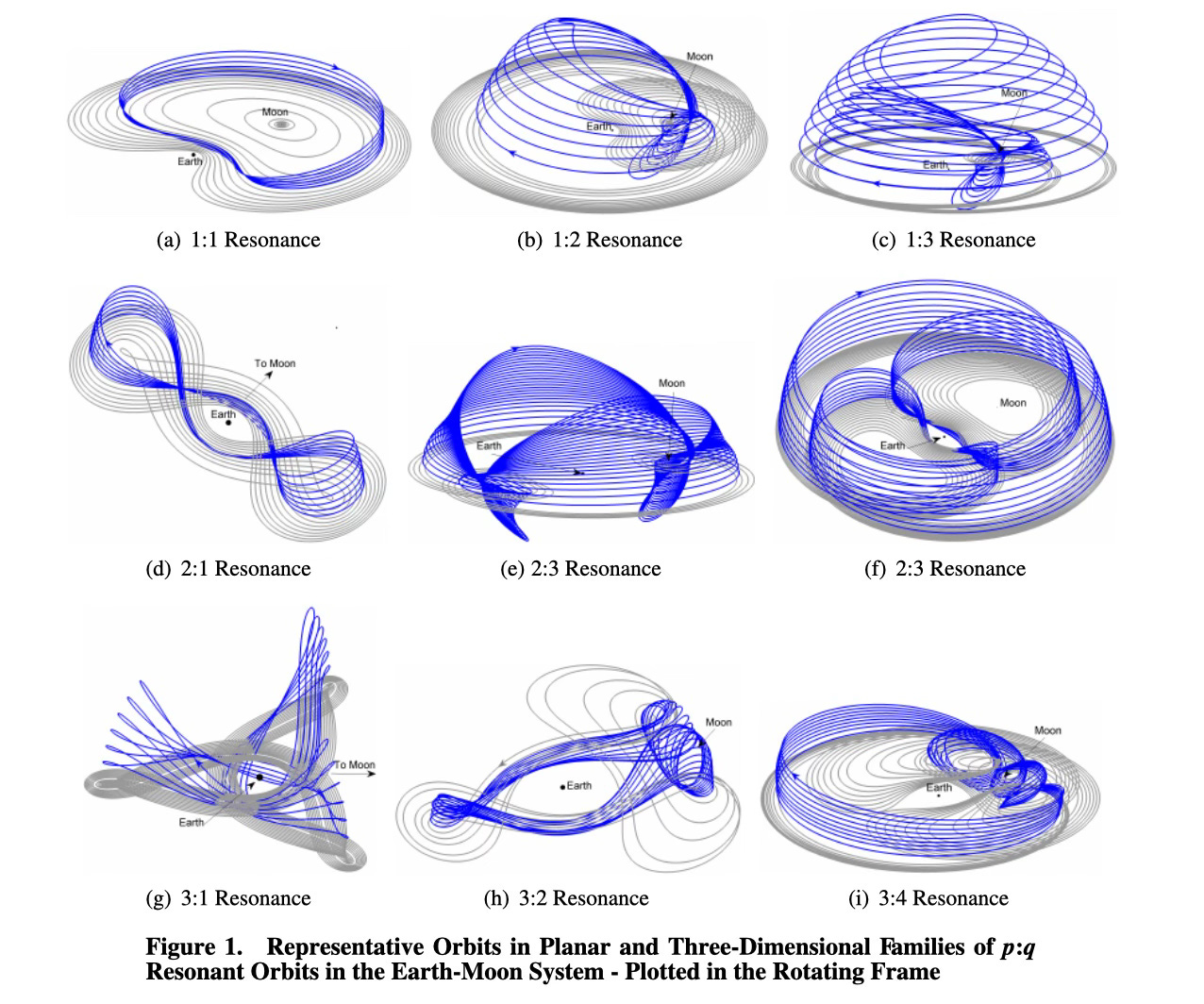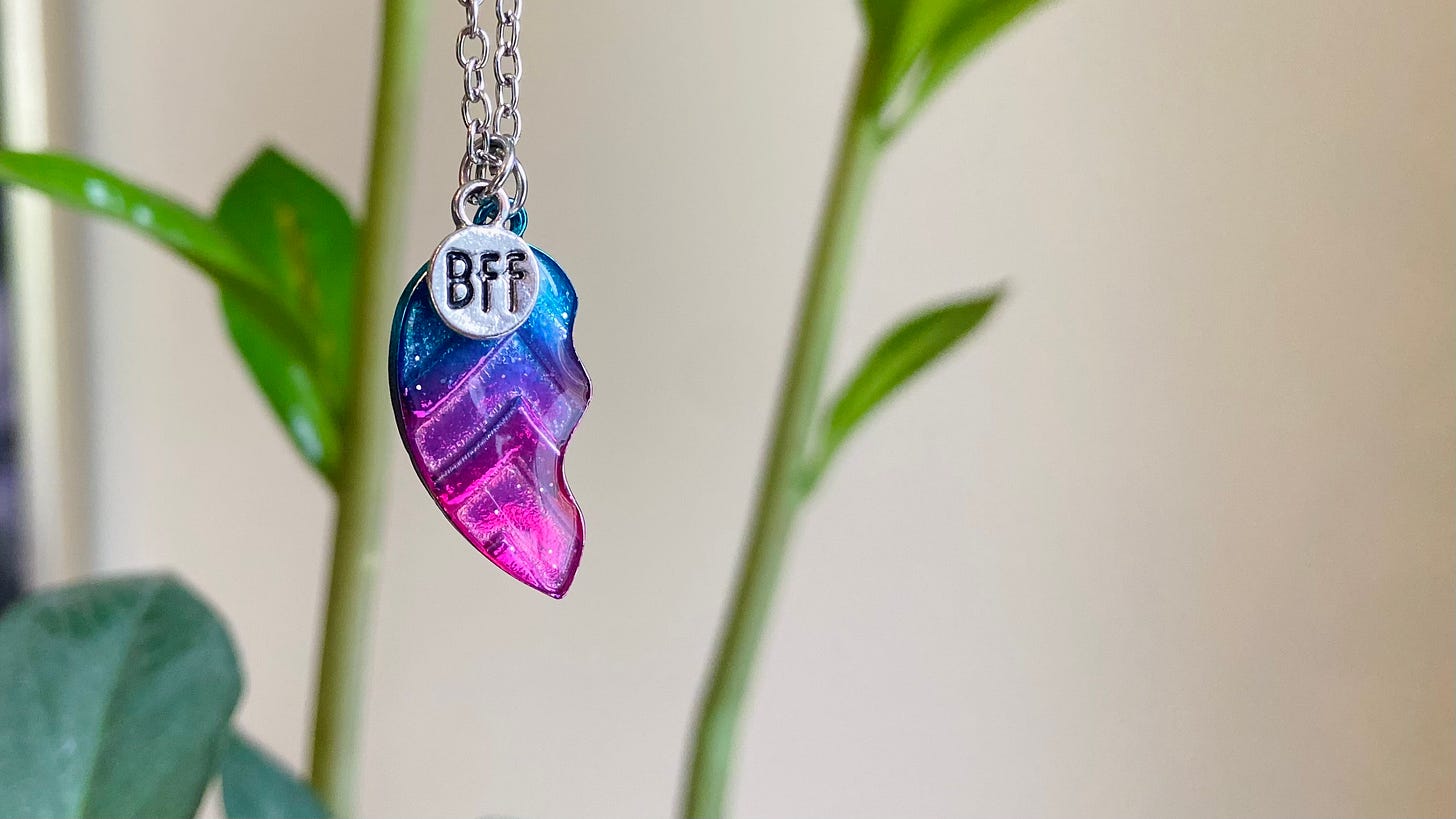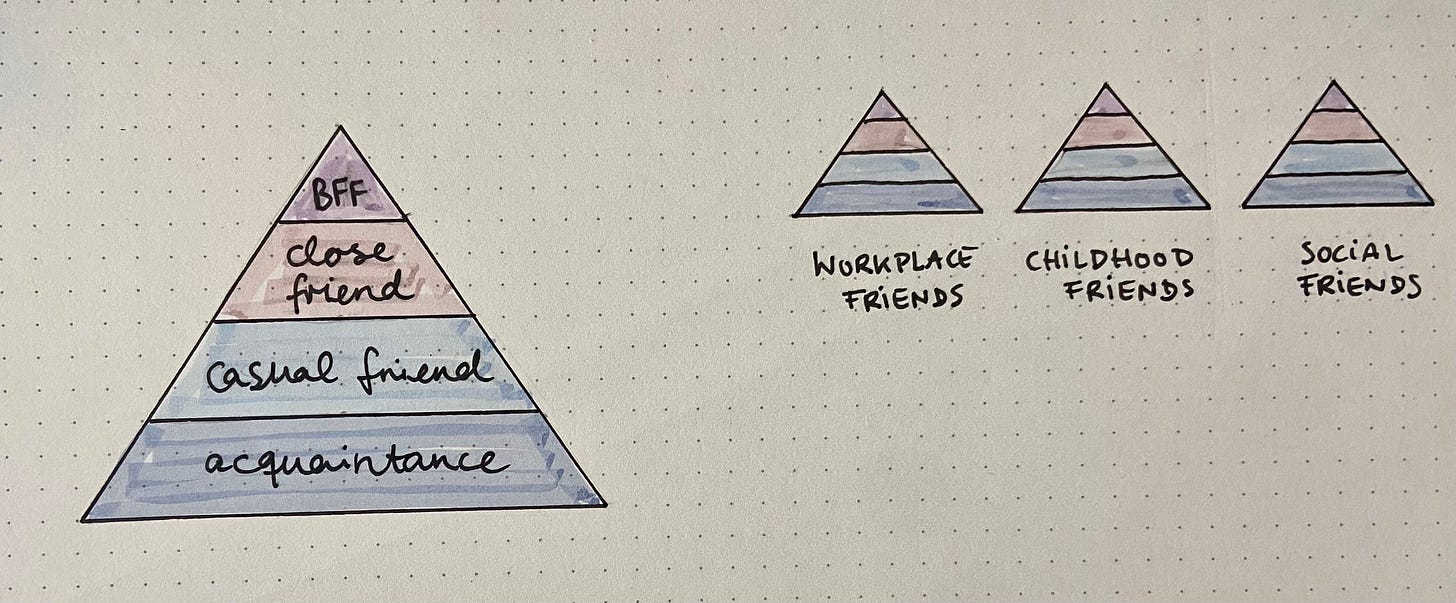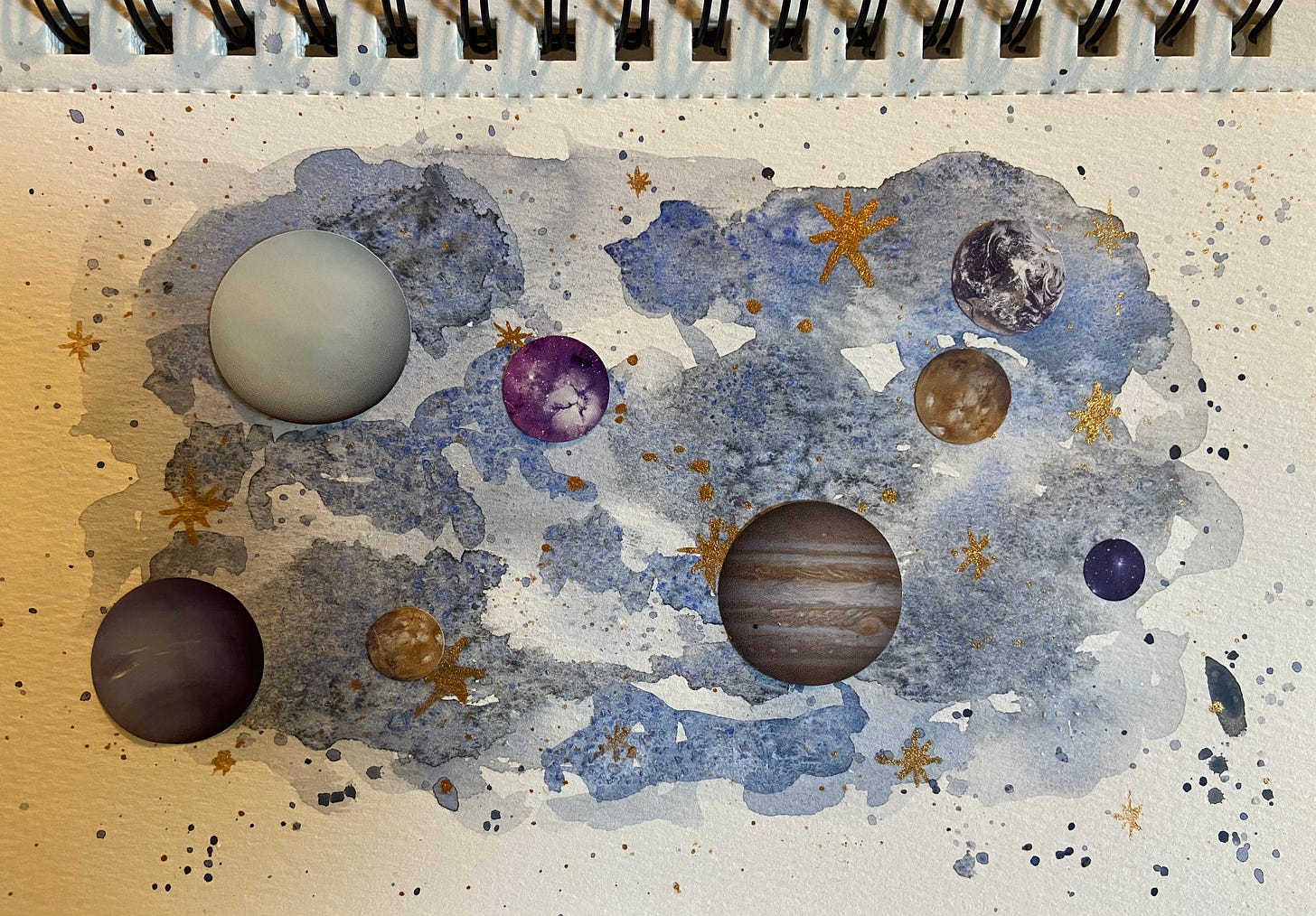Neurotypical vs. Neurodivergent Friendship
Neuroqueering Friendship - Part One. An exploration and a celestial metaphor!
Hello friend,
last week, we explored the pain around friendship loss through a neurodivergent lens with a guest essay. I am so pleased that it resonated with many of you. Through conversations, I am learning that we don’t talk about friendship explicitly much and I keep hearing stories about heartbreak, grief, and confusion about what it means to be a good friend.
Today, let’s explore neurotypical and neurodivergent1 friendship. I would love for this to be a conversation; these are just my initial ideas and I want to hear from you: what resonates? what ideas and metaphors does it spark for you?
Join me in the comments or reply to this email.
The Basics: How to Become Friends
You start as acquaintances because your social circles overlap: at school, work, or through a shared interest or friend.
You spend time together and progress to a casual friend. You might get coffee together and chat about surface level topics like what you do for work, your family, your interests. Small talk is appropriate here.
Over time, you share vulnerable moments and glimpse into parts of your life that not everyone gets to see, elevating you to close friends. You celebrate milestones like birthdays and you spend in-person time together.
If you’re lucky, your shared experiences, similar lifestyles, and time spent together in person might result in the sought after label: BFF - best friends forever!
Whether your friendship starts as coworker acquaintances, classmates, or yoga buddies, as your friendship deepens and evolves, you move up the ladder: acquaintance → casual friend → close friend → best friends.
If this all makes sense to you and this is how you experience friendship - good for you!
If, on the other hand, these concepts sound somewhat familiar and yet so strange and confusing, welcome to the club! This hierarchical evolution of friendship, my friend, describes neurotypical friendships2.
Neurotypical Friendship is Hierarchical & Static
Realizing that neurotypical friendship is hierarchical was a key aha moment for me - no wonder it’s confusing for neurodivergent folks!
This hierarchy (acquaintance → casual friend → close friend → best friends) means two things:
You can go up and down in “rank” as a friend. If you don’t know what rank you’re in at any given time and what the corresponding unspoken rules and expectations are, it’s going to be really tricky to navigate (and easy to fall into people pleasing mode!).
There is a hierarchy within friendship groups - some are
bettercloser friends than others and there’s only room for one BFF on the top (or is this just my literal thinking that there can only be one “best”?). Not intuitively understanding the unspoken rules around these dynamics can make it incredibly difficult to navigate relationships in groups!
Neurotypical friendship is also static. There’s usually no overlap: You’re either a workplace friend or a childhood friend, not both. You can’t be a casual friend and a close friend at the same time. Each friend occupies a clear role.
If this resonates at all, I invite you to pause for a moment here and - if you can - show your younger self a little bit of compassion.
It makes sense that the hierarchical structures of friendship have been difficult to navigate for you.
It makes sense that the roles and rules have been confusing.
It makes sense that you fell into patterns and behaviors that felt safe at the time.
So, if neurotypical friendships are hierarchical and static, then what are neurodivergent friendships like?
Neurodivergent Friendship is Dynamic and Adaptive.
Neurodivergent friendships are dynamic and adaptive, with individuals playing different roles at different times:
Interest based friends - people who are connected by shared passions or topics.
Transactional friends - relationships that involve a specific exchange, like advice, help, or support in a practical sense.
Emotional safety friends - people around whom you can unmask and be vulnerable. For many of us late realized neurodivergent people, this can include people who are on a similar journey of re-discovery.
Routine friends - classmates, coworkers, or neighbors who you interact with in a specific context. You’re friendly, but the connection may not go beyond the specific context.
Deep dive friends - friends that go down the rabbit hole with you! This friendship is marked by long, focused conversations about topics of a shared interest. You might skip small talk entirely. Instead of progressing to this level over time, you might jump straight into monotropic deep talk.
Long-distance friends - people you connect with mainly through text, online, or other asynchronous methods. Sarah Shotts wrote a great article on The Benefits of Asynchronous Friendship.
Instead of progressing hierarchically (acquaintance → casual friend → close friend → best friend), in neurodivergent friend relationships, individuals shift fluidly between different roles based on interest, capacity, circumstances, and needs.
What other roles would you include? Share in the comments!
Take a moment to think about some of your friends. What roles do they play? And what roles do you play in your different relationships?
Neurodivergent Friendships as Celestial Systems — an Attempt At a Metaphor
Let’s explore next how a celestial metaphor might help us make sense of the dynamics of shifting roles. Marta Rose’s writing on Spiral Time sparked this idea: What if we experience friendship in spirals, like planets orbiting around one another; drifting apart at times until we’re pulled back together? An ecosystem of interdependent motion, governed by invisible, dynamic forces.
Let’s draw out some specific parallels between celestial systems and friendships
Orbits aren’t perfect circles; they’re ellipses. A planet may swing closer during one phase (connection) and drift further away during another (independence).
In what ways might your friendships thrive if you embraced this elliptical dance?
Over time, planets capture moons, lose them, or collide to form something new. Friendships are not static; they evolve. You might start as someone's guide (sun) and later become their support (moon), or shift to a star that provides light from afar.
What does your friendship galaxy look like at the moment? What roles are you each playing? Who are the suns, moons, and stars in your galaxy?
Every celestial body exists within a larger, interconnected system: galaxies, clusters, and the universe itself. Friendships don’t exist in isolation—they’re part of a broader ecosystem of relationships, communities, and contexts. A shift in one friendship can ripple out to others, much like the gravitational pull of one planet subtly influences the rest of its system.
What shifts are you’re noticing in your universe? What forces are at play that might have a ripple effect on the rest of your system?
Some friends are like comets—they come into your orbit occasionally, bringing brilliance and intensity for a short time before continuing their journey. These friendships might not be consistent but remain meaningful.
Looking back, who have been some of your comet friends? What was it like to have their energy in your orbit?
Distant friends act like stars, always present in the background of your universe. You navigate by their light even when you're not directly interacting.
What role do your distant star friends play in your life? Think of your distant friends next time you see stars in the night sky and send some love their way.

I hope this exploration sparked some ideas for you. Please share your thoughts in the comments or reply to this email.
Next week, I’ll share a list of specific ideas for how to break away from neuronormative friendship ideals with your friends, treating your friend relationships less like a hierarchical structure and more like a celestial system.
With love & care,
Hanna
P.S.: If you could benefit from some space to think about your friendships and what changes you might want to make, I’m here to support you. Send me an email or message now to learn more.
When I talk about neurodivergent friendship here, I am honestly not sure if it’s this goes for all neurodivergent friendships or if its’ an autistic/ ADHD experience. I wonder if dyslexic people or those hearing voices also experience friendship in these ways. If you have something to contribute, please share!
I think! Your thoughtful & respectful disagreement is welcome here.







This is so beautiful, in every possible way. Thank you. 💜
I think my literal (undiagnosed autistic) thinking as a kid is part of the reason that I clung to friends so hard. I was so worried about having/being a "best" friend and then I'd feel abandoned when my one friend wanted to be close with anyone else, especially if I didn't get along with their other friends. I got pushed out of a friend group toward the beginning of middle school that way, and it felt like I had to start all over again. It was so daunting.